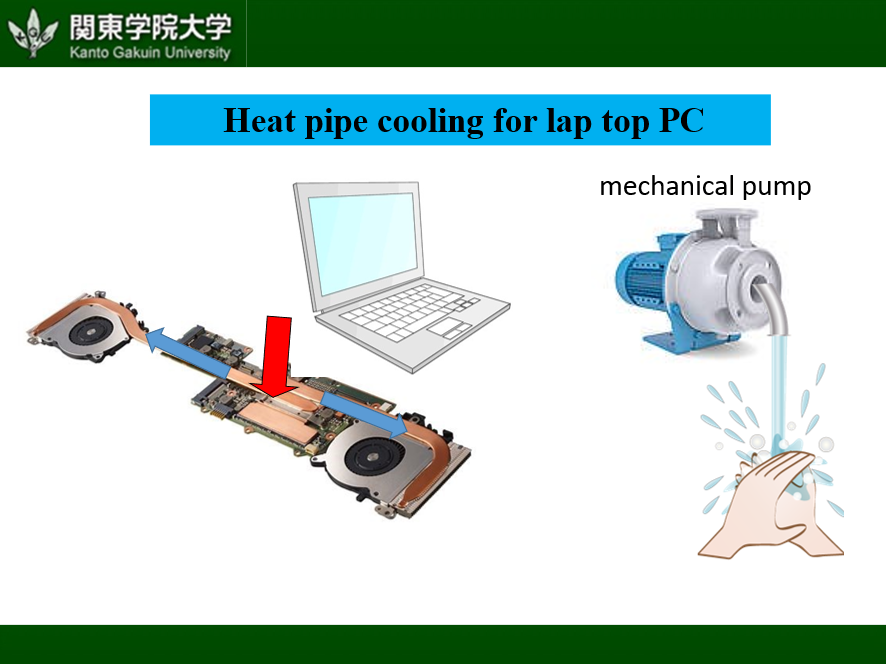[理工学部、建築・環境学部教養学会ミニ講演会] (第65回理科系学生のための公開英語講演会)
Capillary Pumped Loop: Expertise for Heat Transfer
『キャピラリーポンプループ』
講師:理工学部理工学科、先進機械コース
辻森 淳 先生

On May 27th, 2024, the 65th session of the English Lecture Meeting for Science Major Students was held under the sponsorship of the Academic Society of Faculty of Liberal Arts, inviting Dr. Atsushi Tsujimori in the College of Science and Technology to give a lecture with the above title, which was the 8th opportunity on which the lecturer gave a talk to the audience consisting mainly of science major students.
Dr. Tsujimori started this lecture with the following words: “We already live in the age of space travel provided that our pockets are deep enough. Among the companies that sell tickets for short space travels are X COR Aerospace, World View Enterprises, Virgin Galactic, Blue Origin, Space Adventures and Space Exploration Technologies. Here is how Virgin Galactic’s SpaceShip will give you 90 minutes journey to the space.”
The 90-minute journey begins with a smooth runway take-off, as the spaceship, attached to the mothership, ascends towards the skies. Having climbed to the release altitude, the spaceship is freed from the mothership. A few short moments later, the rocket motor equipped with the spaceship will be ignited, quickly reaching the speed up to three and a half times that of sound. After approximately 60 seconds, you will already be in space. At this point you’ll float effortlessly out of your seat in micro-gravity.
One might say this is an astonishing achievement that we humans have ever dreamed of. However, we should not be overjoyed too much with this feat because the spaceship is equipped with a lot of mechanical devices, which means that they might break down at any moment for some reason or other. This fact holds true of artificial satellites which orbit the Earth all the more because their mission lasts much longer than that of spaceships. In short, as long as mechanical devices are operated by mechanical force, it is possible that they will break down. Then, what should we do for us to rest assured that no mechanical disorder will occur in the space? In this lecture, Dr. Tsujimori introduced to the audience a cooling device called “capillary pumped loop” that can operate neither with mechanical force nor with mechanical switches as one of its developers.
In the introduction of this lecture, the lecturer first reminded the audience of the fact that currently countless satellites are orbiting the Earth, constantly sending a lot of information to the Earth.

As can be easily imagined, electronic devices mounted on satellites such as microprocessors give off heat as a result of their operations, as do the electric devices around us. A problem, however, is that it is not an easy task to remove the devices in satellites of the heat flux they yield mainly for two reasons: first, the packaging size of electronic devices on satellites is extremely minimized for the obvious reason that the space in satellites is quite limited, making it difficult to mount the cooling devices adjacent to the heat sources; secondly, the source of power available for driving the cooling devices in satellites is also limited. Besides, too complicated a design cannot be adopted for cooling devices in satellites because nobody can repair them when they get out of order.
Being confronted with this dilemma, researchers of Thermal Engineering (including the lecturer himself) needed to develop a cooling device which can do away with a mechanical pump (thereby consuming no energy source for its operation), and what is more, hardly breaks down.
What attracted the attention of developers faced with this difficult situation was a heat transport loop called a “heat pipe system,” which was already commercially available for such devices as laptop computers. Notably, the heat pipe system was so designed that, being placed in extremely cramped space of laptop computers, it did not need to be driven by a mechanical pump, but it could operate solely by means of “capillary pumping force.”
The next question is how the heat pipe can work without a mechanical device only making use of capillary phenomenon. Dr. Tsujimori went on to elaborate on the mechanism of the heat pipe system and showed how it was improved and adopted as a cooling device mounted on satellites as “capillary pumped loop.”

After the lecture, seven questions were asked by the audience, two of which are represented by the following. Professor Tsujimori gave detailed answers to all those questions.
Q. I learned in the text that the Loop heat pipe has some good points. Does the LHP have any advantages in its environmental effect over other heat transmission systems?
A. Almost all the heat transport systems require a driving force, such as an electric motor or an engine to circulate working fluid, resulting in consumption of energy and an increased impact on environment. Loop heat pipes or capillary pumped loops driven by waste heat needs neither of them.
Q. I learned in the text that Loop Heat Pipe can transport a large heat load over a long distance with a small temperature difference. My question is over how long a distance LHP can transport the heat load.
A. As far as I know, the longest distance over which the heat load was transported was 15m, which is what I accomplished in 1999. Usually, the length of heat transport is two to three meters, which is two to three times as long as that of a heat pipe.







